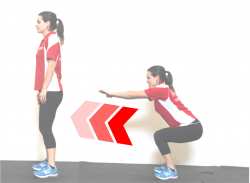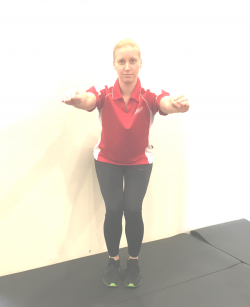A squat is great functional, compound exercise that uses the large muscles surrounding of the legs including glutes, hamstrings, quads and calves. A squatting movement is used in real life every time we sit down and stand up, and is repeated many times every day. It is the foundational movement for all squatting and jumping exercises in the gym and in sports.
Before you try to do any heavy squats with weights, you need to perfect your body weight squat technique. Why is technique so important? First of all, you need to make sure you’re targeting the right muscles, you don’t want to exacerbate or create any muscle imbalances. Secondly, but perhaps most importantly – you want to avoid injuries.
The perfect squat
To complete a perfect, basic, bodyweight squat, follow these steps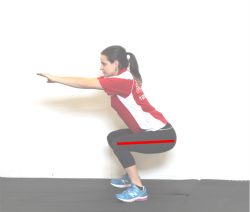
- Stand with your feet about hip-width apart or slightly wider, and have toes facing forward or just slightly turned out
- Keeping your back flat, chest and head up, sit your bottom down like you’re trying to sit on a seat that is about 30cm behind you (you can actually use a chair as a reference when you’re practicing)
- Don’t let your knees come over your toes
- Stop when your thighs are parallel to the floor (hips and knees both at 90°) and pause for a second.
- Squeeze your glutes and slowly raise back up to your starting position
Common mistakes
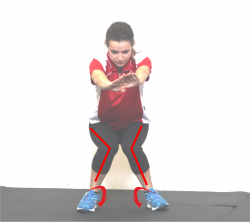 |
Knees buckling inWhen we squat the knees should stay in line with the feet. Our knees tend to follow our feet when we squat so if you find your knees bucking in, try turning your toes slightly out. These issues may also be linked to over pronated feet (rolling inwards) which may require orthopaedic inserts. |
Knees bowing outAs above, knees bowing out ten to be linked to issues at the foot/ankle. If your knees are bowing out, turn your toes slightly in. This issue may also be linked to over supinated feet (rolling outwards) which may require orthopaedic inserts. |
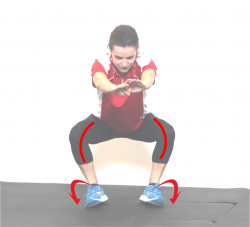 |
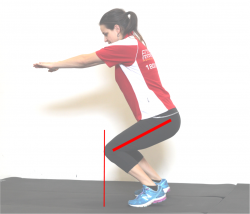 |
Knees coming over toesIf your knees push too far forward in front of your toes it can result in heels lifting, and extreme amounts of pressure placed on the tendons and ligaments around your knees. This can result in inflammation and overuse injuries in the knees. |
Too ShallowIf your squats are too shallow you’re not getting the full benefit of taking your muscles and joints through their full range of motion. You will miss out on the lengthening or ‘stretching’ part of the movement and have an excessive focus on the shortening or ‘tightening’ phase. |
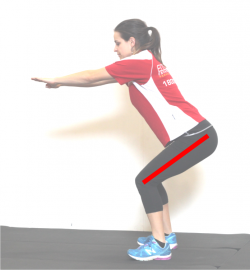 |
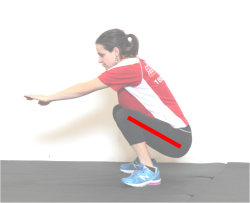 |
Too DeepIf you are squatting BELOW parallel to the floor, your hips will not allow any further flexion and your pelvis will begin to tuck under, so your low back rounds order to accommodate the remaining amount of movement. This places unnecessary stress on the lower spine. |
Back arching excessivelyIf you already have an anterior pelvic tilt like most of us do from sitting down all the time, then your back is already arching more than it should. It is natural for your tight hip flexors and weak glutes to pull your pelvis forward and exaggerate this posture when you’re under stress in a squat movement. In order to reduce pressure on the lower back it is important to be mindful of trying to keep your pelvis and spine neutral. It is also important to be aware that based on the length of the limbs and the torso, people will need to tilt their torso forward to different degrees in order to keep their balance during a squat. Don’t worry if you are leaning your torso a little bit further forward if you know that you have long legs, as long as you are hinging from the hips and keeping your spine neutral. |
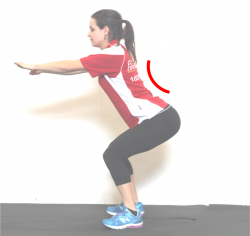 |
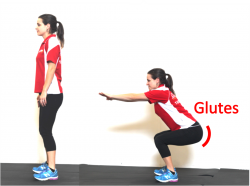 |
Not using your glutesIt is common to be quad-dominant, meaning your quads on the front of your leg are stronger than your glutes/hamstrings on the back of your leg. So when you are performing a challenging exercise, your stronger muscles naturally take the lead. It is important to consciously contract your glutes (your bum muscles) as you lift up from bottom of the squat back to standing in order to strengthen these important hip extensors! |
Going too fastGoing too fast will reduce the amount of tension placed on the muscles, and reduce the amount of effort needed to complete an exercise. You will see a lot of people bouncing at the bottom of the squat, effectively ‘cheating’ by using momentum instead of muscle strength to get back up. This applies to all exercises, but particularly in a squat. Ideally you should lower yourself slowly to the bottom position where your thighs are parallel to the floor, then pause for a second, before squeezing your glutes and slowly rising back up to starting position. This slow speed and pause at the bottom helps to prevent the use of momentum and maximise muscle activation. |
|
|
|
Stance too narrowWhen you squat your feet should be hip width apart or slightly wider. The wider your feet are, the more stable you are, so if you find it very challenging, a wider stance will help keep give you a bigger base of support |
…

